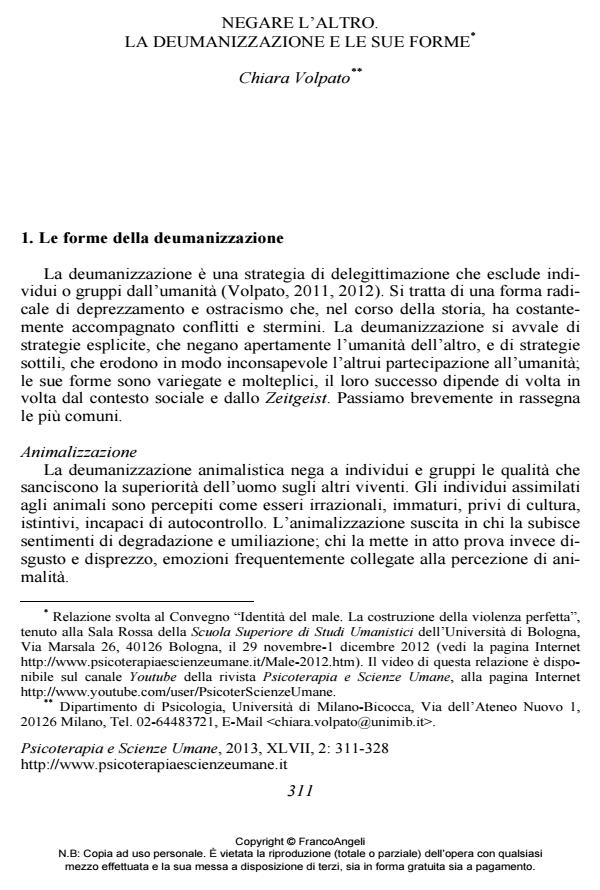Negare l’altro. La deumanizzazione e le sue forme
Titolo Rivista PSICOTERAPIA E SCIENZE UMANE
Autori/Curatori Chiara Volpato
Anno di pubblicazione 2013 Fascicolo 2013/2
Lingua Italiano Numero pagine 18 P. 311-328 Dimensione file 275 KB
DOI 10.3280/PU2013-002012
Il DOI è il codice a barre della proprietà intellettuale: per saperne di più
clicca qui
Qui sotto puoi vedere in anteprima la prima pagina di questo articolo.
Se questo articolo ti interessa, lo puoi acquistare (e scaricare in formato pdf) seguendo le facili indicazioni per acquistare il download credit. Acquista Download Credits per scaricare questo Articolo in formato PDF

FrancoAngeli è membro della Publishers International Linking Association, Inc (PILA)associazione indipendente e non profit per facilitare (attraverso i servizi tecnologici implementati da CrossRef.org) l’accesso degli studiosi ai contenuti digitali nelle pubblicazioni professionali e scientifiche
La deumanizzazione è una delle strategie più usate per delegittimare l’altro, escluderlo dalla cerchia di coloro che sono considerati umani, e giustificare misure di estrema crudeltà. Essa può assumere la forma dell’animalizzazione, della demonizzazione, della biologizzazione, della meccanizzazione, dell’oggettivazione, dell’invisibilità. Dopo una breve rassegna degli studi psicosociali sulla deumanizzazione, il presente lavoro si concentra sulla deumanizzazione degli ebrei nella propaganda fascista attraverso l’analisi di una serie di immagini tratte da La difesa della razza, rivista pubblicata dall’agosto 1938 al giugno 1943 con lo scopo di diffondere nel popolo italiano sentimenti razzisti e antisemiti.
Parole chiave:Deumanizzazione, razzismo, antisemitismo, oggettivazione, propaganda
- Nowe formy komunikacji a dehumanizacja Małgorzata Bulaszewska, in Rocznik Medioznawczy /2025 pp.51
DOI: 10.12797/RMedio.03.2024.03.03 - Dehumanizacja w komentarzach internetowych w polskich portalach informacyjnych. Identyfikacja i klasyfikacja zjawiska na przykładzie odbioru Fransa Timmermansa Arkadiusz Domagała, in Zarządzanie Mediami /2021 pp.451
DOI: 10.4467/23540214ZM.21.024.13755 - Un lutto speciale. Delegittimazioni culturali e rappresentazioni della morte nella perdita di un animale domestico Ines Testoni, Loriana De Cataldo, in PSICOTERAPIA E SCIENZE UMANE 3/2017 pp.413
DOI: 10.3280/PU2017-003004 - Язык как орудие дегуманизации в языковом пространстве вооруженного конфликта в Украине Paulina Bortnowska, in Studia Rossica Posnaniensia /2024 pp.185
DOI: 10.14746/strp.2024.49.2.11
Chiara Volpato, Negare l’altro. La deumanizzazione e le sue forme in "PSICOTERAPIA E SCIENZE UMANE" 2/2013, pp 311-328, DOI: 10.3280/PU2013-002012